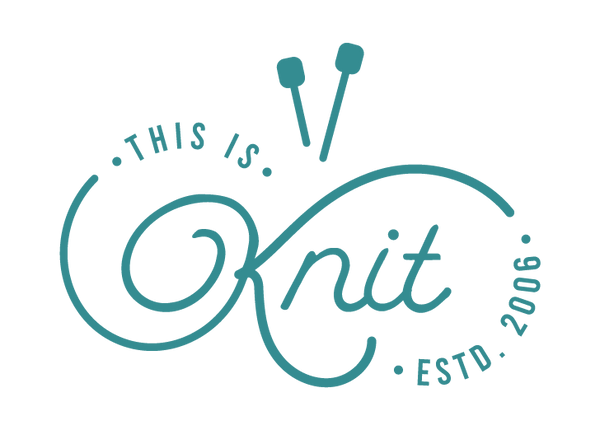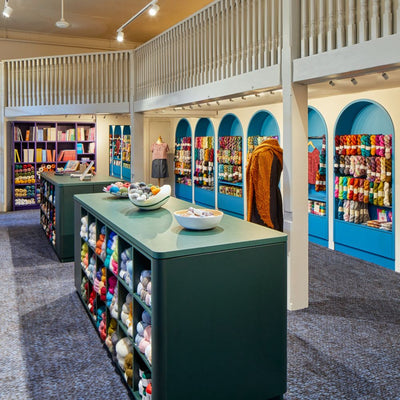Pfeilraupe: Short Rows
April 11 2016 – Holly
We're back for more Pfeilraupe today, with another post in our techniques tutorial series for this pattern. This beautiful and unique shawl is a free pattern available on Ravelry, and has been translated from German, so we've been compiling some tips and advice to help you navigate this foreign beauty. Previously we covered the crochet cast on to get you started, and today we're diving into short rows.
There are many different methods you can use to accomplish short rows, and as they all have the same result, the method you use will often only vary in how to handle the stitch when turning your work, and how to handle the stitch when coming across it in the next row. In this pattern, there is no wrap to be worked, and therefore no second step when handling the turning stitch on the following row. You simply knit to the designated stitch, leave your yarn at the back of the work, and turn.
 Now the working yarn is towards you. Slip the first stitch on your left needle (the last stitch you worked before turning) to the right needle.
Now the working yarn is towards you. Slip the first stitch on your left needle (the last stitch you worked before turning) to the right needle.
 Bring the working yarn to the back of the work, and continue knitting the row.
Bring the working yarn to the back of the work, and continue knitting the row.
 Because the turning stitch will always be at the cast on edge, it is a fairly invisible transition. Without the wrap, you also don't have any bulk in the turning stitch, so the bottom edge is very smooth and there are no bumps where your short rows are turned.
This pattern is a great way to showcase variegated yarn; the yarn in this sample is the lovely Pittura by Louisa Harding in colour 601 which we just love!
Next time we'll talk about working the slots, which create the holes which you can weave the long end through.
What short row method do you prefer? Have you added the Pfeilraupe to your queue yet?
Because the turning stitch will always be at the cast on edge, it is a fairly invisible transition. Without the wrap, you also don't have any bulk in the turning stitch, so the bottom edge is very smooth and there are no bumps where your short rows are turned.
This pattern is a great way to showcase variegated yarn; the yarn in this sample is the lovely Pittura by Louisa Harding in colour 601 which we just love!
Next time we'll talk about working the slots, which create the holes which you can weave the long end through.
What short row method do you prefer? Have you added the Pfeilraupe to your queue yet?
 Now the working yarn is towards you. Slip the first stitch on your left needle (the last stitch you worked before turning) to the right needle.
Now the working yarn is towards you. Slip the first stitch on your left needle (the last stitch you worked before turning) to the right needle.
 Bring the working yarn to the back of the work, and continue knitting the row.
Bring the working yarn to the back of the work, and continue knitting the row.
 Because the turning stitch will always be at the cast on edge, it is a fairly invisible transition. Without the wrap, you also don't have any bulk in the turning stitch, so the bottom edge is very smooth and there are no bumps where your short rows are turned.
This pattern is a great way to showcase variegated yarn; the yarn in this sample is the lovely Pittura by Louisa Harding in colour 601 which we just love!
Next time we'll talk about working the slots, which create the holes which you can weave the long end through.
What short row method do you prefer? Have you added the Pfeilraupe to your queue yet?
Because the turning stitch will always be at the cast on edge, it is a fairly invisible transition. Without the wrap, you also don't have any bulk in the turning stitch, so the bottom edge is very smooth and there are no bumps where your short rows are turned.
This pattern is a great way to showcase variegated yarn; the yarn in this sample is the lovely Pittura by Louisa Harding in colour 601 which we just love!
Next time we'll talk about working the slots, which create the holes which you can weave the long end through.
What short row method do you prefer? Have you added the Pfeilraupe to your queue yet?


2 comments
Hi Sharon, Yes, you’re correct. You use this method of the short rows on the cast on side, and then the “double stitches” for the opposite edge. I will be covering that in another post, but you can definitely use the wrap and turn method on both edges if you prefer! Best of luck with your shawl and hope the upcoming posts are helpful for you as well!
In the Pfeilraupe pattern as written in the English translation, it seems that the author of the pattern used a different technique for each of the long edges. This is what is says: “The lower long edge is formed by a series of short rows. I have not worked a double stitch here, but simply turned the work, slipped first stitch with yarn in front and tightened the yarn, so that the stitches are neat and firm. This gives a nicer edge than using double stitches.” She then uses the double stitch (German short row stitch) on the other long side. Am I reading this correctly, and if so, would doing a simple “wrap and turn” on both sides work just as well? Many thanks for your excellent posts and your input.